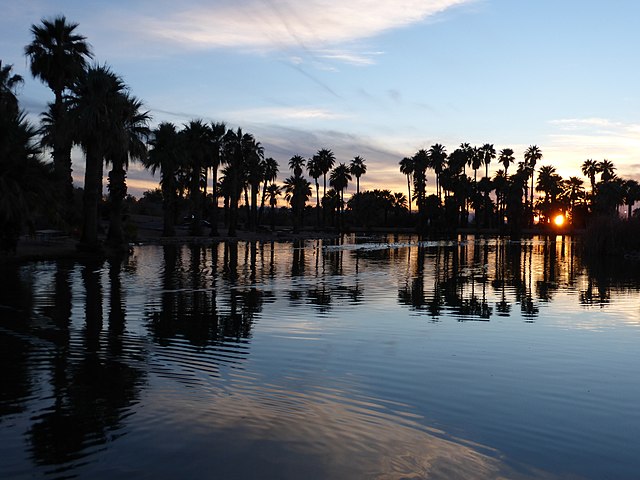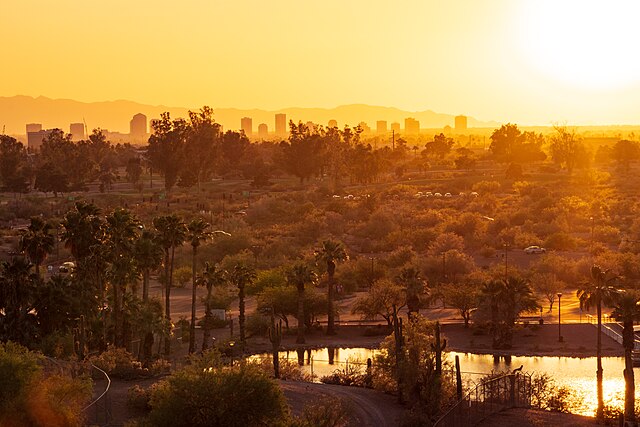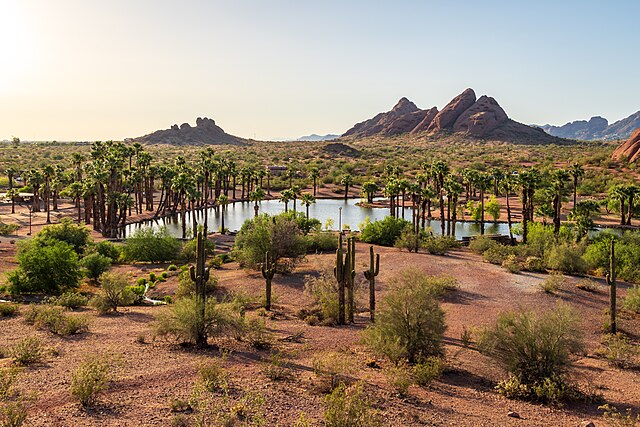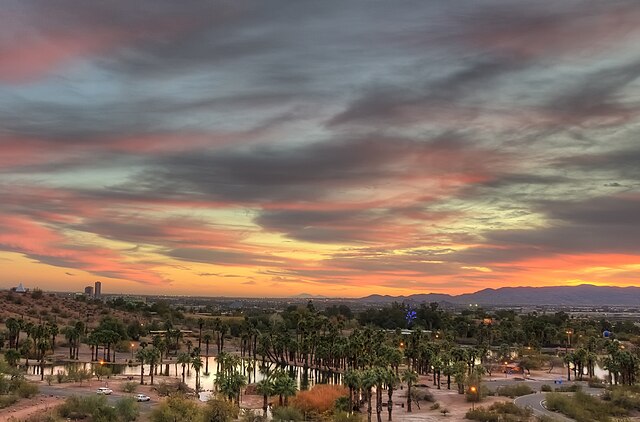Have you ever wondered where locals go to escape the hustle and bustle of Phoenix while staying right in the heart of the city? Look no further than Papago Park, a stunning 1,496-acre desert preserve that serves as an urban oasis for both residents and visitors alike. This remarkable destination offers a perfect blend of natural beauty, recreational activities, and cultural attractions that make it one of Arizona’s most beloved outdoor spaces.
Nestled between Phoenix and Tempe, Papago Park isn’t just another city park – it’s a geological wonderland that showcases the raw beauty of the Sonoran Desert. With its iconic red sandstone formations, diverse wildlife, and world-class attractions, this desert sanctuary provides an unforgettable experience for adventure seekers, families, and nature enthusiasts.
What Makes Papago Park Special?
Location and Accessibility
Papago Park’s strategic location makes it incredibly accessible for both tourists and locals. Situated just minutes from downtown Phoenix and adjacent to Tempe, the park serves as a natural bridge between these two vibrant cities. The convenience factor alone makes it a must-visit destination, but there’s so much more beneath the surface.
The park’s proximity to major highways and public transportation options means you can easily incorporate it into your Arizona itinerary. Whether you’re staying in Scottsdale, Phoenix, or Tempe, you’ll find that Papago Park is never more than a short drive away. This accessibility has made it a favorite among joggers, hikers, and families looking for a quick escape into nature.
Unique Geological Features
What sets Papago Park apart from other desert parks is its fascinating geological history. The park’s signature red sandstone formations were created millions of years ago through a process of sedimentation and erosion. These striking buttes and rock formations create a landscape that looks almost otherworldly, especially during golden hour when the rocks seem to glow with an inner fire.
The most famous of these formations is the Hole-in-the-Rock, a natural window carved by wind and water over countless millennia. This iconic landmark has become synonymous with Phoenix itself, appearing in countless photographs and serving as a symbol of the desert Southwest’s natural beauty.
Top Attractions in Papago Park

Desert Botanical Garden
The Desert Botanical Garden represents one of the world’s finest collections of desert plants, housing over 50,000 specimens from around the globe. This 140-acre garden isn’t just a collection of cacti – it’s a living laboratory that showcases the incredible diversity and adaptability of desert flora.
Walking through the garden’s themed trails, you’ll encounter everything from towering saguaro cacti to delicate wildflowers. The garden’s seasonal displays are particularly spectacular, with spring bringing a riot of color as desert plants burst into bloom. During winter months, the garden transforms into a magical wonderland with their popular Las Noches de las Luminarias event, where thousands of luminarias light up the pathways.
Papago Golf Course
Golf enthusiasts will find themselves in paradise at Papago Golf Course, consistently rated as one of Arizona’s top public courses. This 18-hole championship course weaves through the natural desert landscape, offering challenging play while showcasing the area’s stunning scenery.
The course design takes full advantage of the natural terrain, incorporating the red rock formations and native vegetation into the playing experience. Whether you’re a seasoned golfer or a beginner looking to improve your game, the course offers multiple tee options to accommodate all skill levels. The clubhouse provides excellent dining options and panoramic views of the surrounding desert.
Phoenix Zoo
Home to over 3,000 animals representing more than 400 species, the Phoenix Zoo offers an educational and entertaining experience for visitors of all ages. The zoo’s commitment to conservation and education makes it more than just an attraction – it’s a vital resource for wildlife preservation efforts.
The zoo’s Arizona Trail showcases native wildlife in naturalistic habitats, while the Africa Trail transports visitors to the African savanna. Don’t miss the opportunity to ride the Safari Train, which provides a unique perspective of the zoo’s expansive grounds while offering relief from the Arizona sun.
Best Hiking Trails and Outdoor Activities

Hole-in-the-Rock Trail
The Hole-in-the-Rock Trail stands as Papago Park’s most popular hiking destination, and for good reason. This relatively easy 0.2-mile trail leads to a natural rock formation with a distinctive hole that frames the valley below. The trail is perfect for families and beginners, offering a rewarding destination without requiring extensive hiking experience.
The real magic happens at the top, where you’ll find yourself looking through the famous “hole” toward the Phoenix skyline. This vantage point provides some of the best sunset views in the entire valley, making it a favorite spot for photographers and romantic evening outings. The trail can get crowded, especially during peak season, so arriving early in the morning or later in the afternoon often provides a more peaceful experience.
Double Butte Loop Trail
For those seeking a slightly more challenging adventure, the Double Butte Loop Trail offers a 2.3-mile journey through diverse desert terrain. This moderate trail takes you around and between two prominent buttes, providing constantly changing perspectives of the surrounding landscape.
The trail showcases the park’s geological diversity, passing through washes, over rocky terrain, and alongside native plant communities. Along the way, you’ll encounter ancient petroglyphs left by the Hohokam people, adding a cultural dimension to your hiking experience.
Trail Difficulty and Tips
Most trails in Papago Park are considered easy to moderate, making them accessible to hikers of various fitness levels. However, desert hiking requires special considerations regardless of difficulty level. Always carry plenty of water – at least one gallon per person for longer hikes. The desert sun can be deceptive, and dehydration happens quickly.
Wear appropriate footwear with good grip, as the sandstone can be slippery when wet. Start early in the morning during summer months to avoid extreme heat, and always inform someone of your hiking plans. Consider bringing a hat, sunscreen, and lightweight, long-sleeved clothing to protect against sun exposure.
Rock Climbing Opportunities
Papago Park’s unique sandstone formations provide excellent opportunities for rock climbing enthusiasts. The soft sandstone offers good grip and interesting route variations, though climbers should be aware that this rock type requires careful technique to avoid damage.
Popular climbing areas include the various buttes throughout the park, each offering different challenges and route options. The climbing community here is welcoming to newcomers, and you’ll often find experienced climbers willing to share beta or offer advice. Remember that climbing in the park requires adherence to specific regulations designed to protect both the rock formations and wildlife habitats.
Photography and Scenic Spots
Sunset Viewing Locations
Papago Park transforms into a photographer’s dream during the golden hours of sunrise and sunset. The red sandstone formations seem to catch fire as the light changes, creating dramatic shadows and highlighting the textures of the ancient rock.
The Hole-in-the-Rock provides the most famous sunset viewing experience, but don’t overlook other vantage points throughout the park. The area around the buttes offers numerous elevated positions where you can capture the interplay of light and shadow across the desert landscape. These moments remind you why Arizona sunsets are legendary worldwide.
Instagram-Worthy Photo Spots
Beyond the obvious attractions, Papago Park offers countless opportunities for stunning photography. The contrast between the red rocks and blue sky creates natural frames for portraits, while the diverse plant life provides interesting foreground elements for landscape shots.
Consider exploring the lesser-known corners of the park, where you might discover hidden arches, interesting rock formations, or unique plant specimens. The park’s accessibility means you can easily return to locations at different times of day to capture varying light conditions.
Visitor Information and Planning

Best Times to Visit
Timing your visit to Papago Park can significantly impact your experience. The ideal months for visiting are October through April, when temperatures are more comfortable for outdoor activities. During these months, daytime temperatures typically range from 70-85°F, perfect for hiking and exploring.
Summer visits require more careful planning due to extreme heat. If you must visit during summer months, plan activities for early morning or late evening hours. The park takes on a different character at these times, with cooler temperatures and the possibility of encountering more wildlife as animals emerge from their midday hiding spots.
Parking and Facilities
Papago Park offers several parking areas strategically located near major attractions and trailheads. The main parking area near the Hole-in-the-Rock can fill up quickly, especially on weekends and during peak season. Alternative parking areas are available throughout the park, often requiring a short walk to reach your destination.
Facilities include restrooms, picnic areas, and drinking fountains, though these amenities are somewhat limited given the park’s natural setting. The park’s design prioritizes preservation of the natural environment, so come prepared with your own water and supplies for longer visits.
Entry Fees and Regulations
Access to Papago Park itself is free, making it an excellent budget-friendly option for travelers. However, some attractions within the park, such as the Desert Botanical Garden and Phoenix Zoo, charge separate admission fees. These fees help support conservation efforts and maintain the high quality of exhibits and programs.
Park regulations are designed to protect the natural environment and ensure visitor safety. Pets must be leashed at all times, and owners are responsible for cleaning up after their animals. Rock climbing requires permits in some areas, and camping is not permitted within the park boundaries.
Nearby Attractions and Activities
Tempe Town Lake
Just a short drive from Papago Park, Tempe Town Lake offers a refreshing contrast to the desert environment. This man-made lake provides opportunities for kayaking, paddleboarding, and fishing, while the surrounding paths are perfect for walking or cycling.
The lake area hosts numerous events throughout the year, including outdoor concerts and festivals. The combination of water activities and urban amenities makes it an excellent complement to your Papago Park experience.
Mill Avenue District
The historic Mill Avenue District in Tempe provides dining, shopping, and entertainment options within easy reach of Papago Park. This vibrant area reflects the energy of nearby Arizona State University while offering attractions for visitors of all ages.
The district’s restaurants range from casual cafes to upscale dining establishments, many featuring outdoor seating where you can enjoy Arizona’s famous weather. Local shops offer everything from outdoor gear to unique southwestern gifts, making it easy to find souvenirs or forgotten essentials.
Conclusion
Papago Park stands as a testament to the incredible natural beauty that exists within Arizona’s urban areas. This remarkable destination offers something for everyone, from challenging hikes and world-class attractions to peaceful moments of reflection in a stunning desert setting. Whether you’re a first-time visitor to the Phoenix area or a longtime resident looking for a new adventure, Papago Park provides an accessible gateway to the wonders of the Sonoran Desert.
The park’s unique combination of geological marvels, diverse wildlife, and cultural attractions creates an experience that goes beyond typical outdoor recreation. It’s a place where you can disconnect from the digital world and reconnect with the natural rhythms of the desert, all while remaining within minutes of urban conveniences.
As you plan your visit to Papago Park, remember that the best experiences often come from taking time to truly observe and appreciate the subtle beauty of the desert environment. This isn’t just a destination to check off your list – it’s a place where memories are made and appreciation for our natural world is renewed.
Frequently Asked Questions
Q: Is Papago Park suitable for young children?
A: Yes, Papago Park is very family-friendly! The Hole-in-the-Rock trail is easy enough for children, and the park offers plenty of open space for kids to explore safely. The nearby Phoenix Zoo and Desert Botanical Garden also provide excellent educational opportunities for young visitors.
Q: How long should I plan to spend at Papago Park?
A: A basic visit to see the main attractions can be done in 2-3 hours, but if you want to explore multiple trails, visit the zoo or botanical garden, or enjoy photography, plan for a full day. Many visitors find it worthwhile to return multiple times to fully experience everything the park offers.
Q: Are there guided tours available in Papago Park?
A: While the park itself doesn’t offer guided tours, the Desert Botanical Garden provides excellent guided tours and educational programs. Local tour companies also offer desert hiking tours that include Papago Park as a destination.
Q: What should I bring for a day at Papago Park?
A: Essential items include plenty of water, sunscreen, a hat, comfortable hiking shoes, and snacks. A camera is highly recommended for capturing the stunning scenery. During cooler months, bring layers as desert temperatures can change significantly from morning to evening.
Q: Can I bring my dog to Papago Park?
A: Yes, dogs are welcome in Papago Park but must be kept on a leash at all times. Be sure to bring water for your pet, as the desert environment can be challenging for animals. Clean up after your pet and be mindful of hot pavement that can burn paw pads during summer months.

